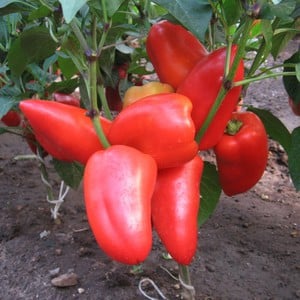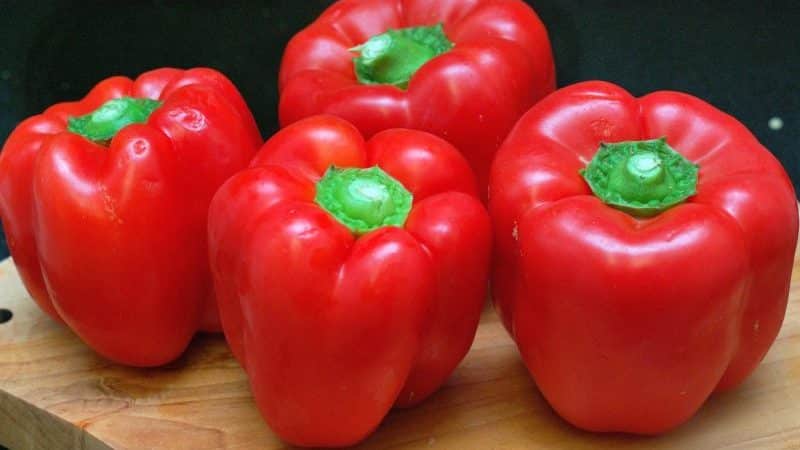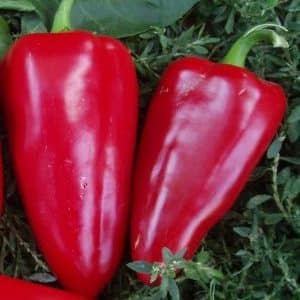Why gardeners love the Bogatyr pepper variety so much and how to grow it correctly
Sweet peppers are famous for their high content of nutrients. Nutritionists recommend including it in the diet of adults and children. This vegetable is consumed fresh and canned, and retains its taste even when frozen.
Among the abundance of varieties, the Bogatyr pepper is the most popular. It is distinguished not only by its excellent taste and high yield, but also by its resistance to adverse environmental factors.
What else will this variety please farmers with and how not to be disappointed in the choice - read on.
What type of pepper is this?
Bogatyr is a variety of bell pepper bred by Moldovan breeders in 1996.
Pepper is included in the state register. Its originator is the Poisk company.
Despite the fact that Bogatyr is a relatively old variety, it remains popular among summer residents. Its seeds are produced by several manufacturers.
This is interesting! Sweet pepper comes from its bitter cousin.
Distinctive features of Bogatyr
Pepper Bogatyr produces large fruits of rich red color. Some of them may have dark green and burgundy spots.
The taste of this type of pepper is sweet - bitterness and sourness are absent even in an unripe vegetable. Rich peppery aroma. Look what Bogatyr looks like in the photo.
The fruits contain a high content of vitamin C. Therefore, the vegetable helps to activate the immune system and remove toxins and bad cholesterol from the body.B vitamins in the composition have a beneficial effect on the condition of the skin, hair and liver.
The main feature of the variety is considered to be cold resistance. Unlike many other varieties of bell pepper, Bogatyr is suitable for growing in regions with cool climates.
Another positive quality of pepper is its high immunity to nightshade diseases. It does not require preventive treatments with chemicals, which allows you to grow an environmentally friendly product.
Negative features of Bogatyr include the fact that different agricultural companies produce plant seeds with different qualities under the same name. For example, depending on the manufacturer, the fruits of this type of pepper can be cuboid or cone-shaped.
General characteristics
Pepper Bogatyr will delight both experienced and novice gardeners. It is distinguished by its ease of care, high yield and large, tasty fruits.
Description and characteristics of the Bogatyr variety:
| Parameter | Indicators |
| Bush type | Low. The height of the central stem varies between 40-70 cm (depending on the manufacturer). The bush is powerful, spreading, heavily leafy. The leaf blade is dark green, slightly wrinkled. |
| Growing method | Suitable for growing in open and protected soils. In the northern regions, fruits only have time to ripen in a greenhouse. |
| Productivity | High. From 1 sq. m harvest up to 7 kg of crop. |
| Fruit | Large ones. The weight of each fruit reaches 150-250 g. The color is deep red inside and outside. The skin is glossy. The shape is cuboid or cone-shaped (depending on the manufacturer). There is pronounced ribbing at the base, which spreads throughout the entire fruit. The wall thickness varies between 5-8 mm (depending on the manufacturer). The pulp is juicy.The taste is sweet with a rich peppery aroma. There is no bitterness even at the stage of technical maturity. |
| Transportability | High. Dense fruits do not wrinkle when transported over long distances. They can be stored for up to a month. |
| Ripening time | Mid-season. Technical ripeness of the first fruits occurs 120-130 days after sowing the seeds. |
| Disease resistance | Has high immunity to pepper diseases. |
Some characteristics of the variety differ depending on the manufacturer:
- "Sedek." The height of the bush is 50-70 cm. The fruits are cone-shaped. Wall thickness – 5-6 mm.
- “Search”, “Aelita”, “Lucky Seeds”. Wall thickness – 5 mm. The shape is cone-shaped. Bush height – 50-70 cm.
- "Siberian seeds". The fruits are cube-shaped. Bush height – 40-50 cm. Wall thickness – 7-8 mm.
The remaining characteristics of the variety are the same for all manufacturers.
Preparation for cultivation
Pepper in our country is grown only by seedlings. Otherwise, the fruits simply will not have time to ripen before the first frost.
Pre-sowing seed preparation consists of several stages:
- Planting material is sorted out. Darkened and damaged seeds are removed. The remaining specimens are soaked in a solution prepared from a glass of water and 1 tsp. salt. Use those seeds that have sunk to the bottom.
- The seeds are soaked in a light pink solution of potassium permanganate (30 minutes), hydrogen peroxide (15 minutes) or aloe juice (12 hours). After this, they are washed with warm water.
After treatment, the growth of planting material is stimulated. This is done in one of the following ways:
- Planting material is wrapped in pieces of fabric moistened with a growth stimulator or warm water. The fabric with the seeds is placed in a deep container, covered with film and placed in a warm place until germination.
- The seeds are soaked for 12 hours.Then they are placed in the refrigerator for the same time.
Pepper seeds are planted in loose nutritious soil. You can buy it in the store (universal soil mixture, soil for tomatoes and peppers) or prepare it yourself. To do this, take one portion each of the base and nutrient substrate and half a portion of baking powder:
- base: garden soil or black soil;
- nutrient substrate: peat or humus;
- baking powder: sawdust, sand, crushed coconut substrate.
A glass of ash and a matchbox of superphosphate are added to the bucket of the mixture. The soil is disinfected with a dark pink solution of potassium permanganate or calcined in the oven.
Seeds are sown in common shallow but wide containers (boxes, trays, packaging for semi-finished products) or individual pots. The second method is preferable, since pepper does not like picking.
It is more convenient to use peat containers: tablets or pots. There is no need to remove seedlings from it when transplanting to a permanent place.
The containers are also disinfected. It is soaked in a solution of potassium permanganate and sterilized with hot steam or boiling water.
Growing seedlings
Before planting seedlings, keep the filled containers at room temperature so that the soil warms up and the seeds germinate faster.
Note! Experienced summer residents always add drainage to the bottom of containers for growing seedlings. For example, sand or shell rock. It is also disinfected.
Sowing of seeds begins 80 days before the intended planting of plants in the ground. Depending on the region, this is done at the beginning of March or at the end of February.
Planting pepper
When sowing peppers in a common box, grooves 2 cm deep are made in the soil at a distance of 3 cm from each other. Seeds are placed in them at intervals of 3 cm. The recesses are sprinkled with soil.
When growing seedlings in individual containers, one seed is sown in each cup. They are buried 1 cm. After true leaves appear on the plants, one sprout is left in one pot, pinching off the weaker stem.
In both cases, containers with seedlings are covered with film and placed in a warm place. Every day the film is opened slightly for 60 minutes for ventilation. The soil is moistened with a spray bottle as it dries.
Further care
In order for seedlings to grow, they need to be provided with proper and regular care. The viability and productivity of pepper in the future will depend on the endurance of young plants:
- When the seeds germinate, the covering (film or glass) is removed. Containers with seedlings are placed on a windowsill or under a fluorescent lamp. If seedlings are grown on a windowsill, the containers are periodically turned towards the window to prevent the stems from tilting to one side.
- Make sure that the seedlings are not exposed to a draft. Yellowing of the leaves indicates not only hypothermia of the plants, but also a lack of sunlight.
- Water the pepper with a spray bottle. This is done every three days. Use water at room temperature.
- When the second true leaf appears, the plants are planted in individual pots. This is done carefully, holding the seedlings by the leaves and using a fork to remove them from the soil along with a lump of earth.
- Feed the seedlings only three times. The first time - when the second true leaves appear, the next two times - every two weeks. They use special preparations (for example, “Krepysh”) or prepare the product themselves (take 10 g of superphosphate and ammonium nitrate, as well as 5 g of potassium salt per 5 liters of water).
- Two weeks before planting in a permanent place, the seedlings begin to harden. She is taken outside, gradually increasing the time of stay.
Growing peppers in a permanent place

Peppers are transplanted to a permanent location in late May or early June. By this time, the soil at a depth of 15 cm should warm up to 15°C. It is important that there is no threat of night frosts.
Five days before planting in a permanent place, the seedlings are watered and fed. This will help her get accustomed to the new place.
Picking to a permanent place
The beds for pepper are prepared in the fall. Choose a well-lit place where nightshade crops have not grown in the previous two years.
The soil is dug up, clearing of plant debris. For every 1 sq. m, add 6 kg of humus and 0.5 kg of ash (if the acidity of the soil is increased). Fertilizers are mixed with soil.
Advice! Instead of humus, some gardeners bury crushed tops of cultivated plants in the soil. In spring it turns into fertile soil.
In spring, the rows are leveled with a rake. For each square meter, add 30 g of superphosphate and 10 g of urea.
The holes are dug in rows in a checkerboard pattern. A distance of 30-40 cm is maintained between each recess. 40-50 cm are left free between the rows.
Pour 1 tbsp into each cavity. l. ash and long-acting fertilizers. Some gardeners, instead of store-bought preparations, place one small fish in each hole.
After this, the pepper is planted, removing it from the pot along with a lump of earth. If peat containers were used, then the seedlings are planted in the ground along with them.
A liter of warm water is poured into each seat. When the liquid is absorbed, the depressions are filled with soil, which is compacted around the plants.
Rules of care
Bogatyr pepper is a low-growing variety. However, it is recommended to tie it up. Once every ten days, the side shoots are removed. The leaves at the bottom of the bush, as well as withered and yellowed greenery, are also cut off.
The variety is demanding when it comes to watering. The soil is moistened every four days, using at least 2 liters of water per plant. It's better to do this in the morning. Before flowering, the pepper is watered with rain, then the liquid is poured only under the root.
After each watering, the soil is loosened. During this procedure, the beds are cleared of weeds.
The beds must be mulched with rotted hay, humus, or just burlap. This layer will slow down the growth of weeds, protect the roots from pests and adverse environmental factors, and serve as additional feeding.
During the season, fertilizing is applied three times. Usually the following scheme is used:
- 14 days after picking to a permanent place. 10 g of superphosphate and 5 g of urea are dissolved in a 10-liter bucket of water. 1 liter of product is poured under each bush.
- During the formation of ovaries. 20 g of potassium and 40 g of superphosphate are diluted in 10 liters of water. Use 1 liter of fertilizer per plant.
- During fruiting. For 10 liters of water take 40 g of potassium and superphosphate. 1 liter of fertilizer is poured under the bush.
Important! Before fertilizing, the beds are watered with clean warm water. This will prevent fertilizers from damaging the roots.
To attract pollinating insects to the bushes during the flowering period, they are sprayed with a special composition. To prepare it, dissolve a glass of sugar and 1 tbsp in a bucket of water. l. boric acid.
Typical diseases and pests
Bogatyr is distinguished by high immunity to nightshade diseases. But harmful insects infect the bushes.
The following means are used to combat:
- Aphid. 10 mg of Karbofos is diluted in 10 liters of water.
- Slugs. Dissolve 10 tbsp in 10 liters of liquid. l. ground red hot pepper.
- Spider mite. In 10 liters of water, 0.5 kg of onion peels and 300 g of chopped garlic are infused for three days.
Advantages and disadvantages of the variety
Benefits of Bogatyr pepper:
- immunity to nightshade diseases;
- large fruits;
- good sweet taste and thick walls;
- resistance to cold weather;
- possibility of growing in open and protected ground;
- the possibility of using seeds from fruits for planting.
Peppers of this variety from different manufacturers have different characteristics. This is considered the main drawback of Bagatyr.
Reviews
Reviews from gardeners about Bogatyr are not always clear. This is due to the fact that from the seeds of this varieties Different growers produce plants that differ from each other.
Alla, Tula: «A couple of years ago I planted Bogatyr. I liked the variety. The peppers are large and cone-shaped, as in the photo. The taste is sweet, the walls are thick. Suitable for freezing, preparing lecho and eating fresh. Last year I bought a replacement of the same variety, but from a different company. The peppers were not so tasty, with sourness and not very thick walls, they would no longer be suitable for lecho. I will now look for the Bogatyr, who I liked.”
Igor, Izhevsk: “Very tasty and beautiful pepper. It is not afraid of cold weather and requires a minimum of care. I didn't even stepchild him. The harvest still turned out great.”
Read also:
Why summer residents love “Swallow” pepper.
Spectacular hybrid pepper "Kakadu".
A hybrid that will not leave you indifferent - “Orange Miracle” pepper.
Conclusion
Bogatyr is an old, proven variety that definitely won’t disappoint. It produces a rich harvest even in cold summers.Pepper is not demanding in care and even an inexperienced gardener can cope with its cultivation.
When choosing Bogatyr pepper seeds, it is important to carefully study the description on the package. Indeed, depending on the manufacturer, some characteristics of its fruits may vary.